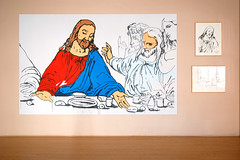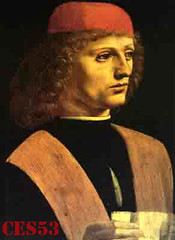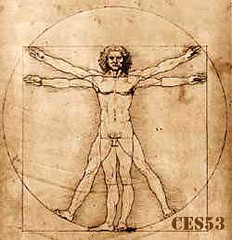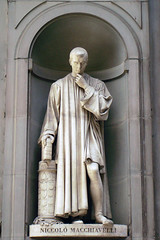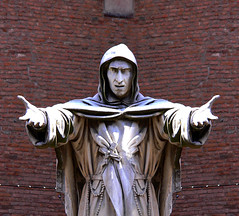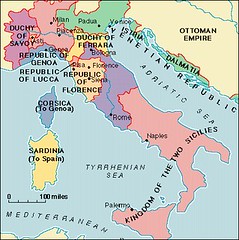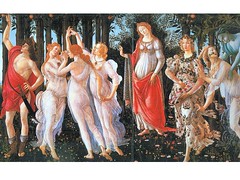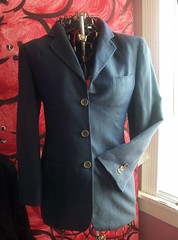Created in the final year of the artist's life, says the Ayn Foundation, "The Last Supper" series (1986-87) is a reflection on one of the most revered paintings in the history of art: Leonardo da Vinci's Last Supper (1495-97). As with much of Warhol's work, "The Last Supper" series is based more on reproductions of a famous image than on the image itself.
Working from photographs, outline drawings, and inexpensive plastic models, Warhol repeatedly worked variations on the scene depicting Jesus Christ surrounded by his disciples.
In so doing, Warhol returned to many of the issues that had informed his oeuvre since the early 1960s: notions of "high" and "low" art; the intersection of the worlds of art, commerce, and religion; the problem of creating an authentic contemporary version of reality; and the central role of the graphic image in the late twentieth century.
In a GoogleDoc, choose 3 pieces by each artist: Leonardo and Warhol.
Add bulleted info that will illuminate the similarities between the 2 artists as well as note differences.
Share w trudeau11@gmail.com under the title "Leonardowarhol."
Due Mon, Ap 5.
Wednesday, March 31, 2010
Tuesday, March 30, 2010
Stratocastrian Man, after Leonardo da Vinci and Leonardo Fender

Stratocastrian Man, after Leonardo da Vinci and Leonardo Fender
Originally uploaded by Mike Licht, NotionsCapital.com
We ask her class to feed us a snack in turn for our infotainment.
Let us draw inspiration from the many parodies of Leonardo's art. See Vitruvian Man fun here.
Wednesday, March 24, 2010
Apotheosis of the Renaissance: Leonardo da Vinci
Solo presentations on Leonardo:
- 10 images (one of them a map of l'Italia)
- bulleted info on his most notable pieces of art, his locations
- documentation
- titling
- brief essay of description and interpretation of one of his works - include documentation.
- Google Doc / presentations
- 10 images (one of them a map of l'Italia)
- bulleted info on his most notable pieces of art, his locations
- documentation
- titling
- brief essay of description and interpretation of one of his works - include documentation.
- Google Doc / presentations
Tuesday, March 23, 2010
Notes on Leonardo da Vinci
Leonardo was and is renowned[2] primarily as a painter, says Wikipedia.
Two of his works, the Mona Lisa and The Last Supper, are the most famous, most reproduced and most parodied portrait and religious paintings of all time, respectively, their fame approached only by Michelangelo's Creation of Adam.[1]
Leonardo's drawing of the Vitruvian Man is also regarded as a cultural icon,[4] being reproduced on everything from the Euro to text books to t-shirts.
Perhaps fifteen of his paintings survive, the small number due to his constant, and frequently disastrous, experimentation with new techniques, and his chronic procrastination.[nb 2] Nevertheless, these few works, together with his notebooks, which contain drawings, scientific diagrams, and his thoughts on the nature of painting, comprise a contribution to later generations of artists only rivalled by that of his contemporary, Michelangelo.
Leonardo di ser Piero da Vinci (1452 – 1519), was an Italian polymath: painter, sculptor, architect, musician, scientist, mathematician, engineer, inventor, anatomist, geologist, botanist and writer.
Leonardo has often been described as the archetype of the Renaissance man, a man whose unquenchable curiosity was equaled only by his powers of invention.[1] He is widely considered to be one of the greatest painters of all time and perhaps the most diversely talented person ever to have lived.
Leonardo was educated in the studio of the renowned Florentine painter, Verrocchio. Much of his earlier working life was spent in the service of Ludovico il Moro in Milan. He later worked in Rome, Bologna and Venice and spent his last years in France, at the home awarded him by Francis I.
He conceptualised a helicopter, a tank, concentrated solar power, a calculator,[5] the double hull and outlined a rudimentary theory of plate tectonics.
Relatively few of his designs were constructed or were even feasible during his lifetime,[nb 3] but some of his smaller inventions, such as an automated bobbin winder and a machine for testing the tensile strength of wire, entered the world of manufacturing unheralded.[nb 4] As a scientist, he greatly advanced the state of knowledge in the fields of anatomy, civil engineering, optics, and hydrodynamics.[6]
Two of his works, the Mona Lisa and The Last Supper, are the most famous, most reproduced and most parodied portrait and religious paintings of all time, respectively, their fame approached only by Michelangelo's Creation of Adam.[1]
Leonardo's drawing of the Vitruvian Man is also regarded as a cultural icon,[4] being reproduced on everything from the Euro to text books to t-shirts.
Perhaps fifteen of his paintings survive, the small number due to his constant, and frequently disastrous, experimentation with new techniques, and his chronic procrastination.[nb 2] Nevertheless, these few works, together with his notebooks, which contain drawings, scientific diagrams, and his thoughts on the nature of painting, comprise a contribution to later generations of artists only rivalled by that of his contemporary, Michelangelo.
Leonardo di ser Piero da Vinci (1452 – 1519), was an Italian polymath: painter, sculptor, architect, musician, scientist, mathematician, engineer, inventor, anatomist, geologist, botanist and writer.
Leonardo has often been described as the archetype of the Renaissance man, a man whose unquenchable curiosity was equaled only by his powers of invention.[1] He is widely considered to be one of the greatest painters of all time and perhaps the most diversely talented person ever to have lived.
Leonardo was educated in the studio of the renowned Florentine painter, Verrocchio. Much of his earlier working life was spent in the service of Ludovico il Moro in Milan. He later worked in Rome, Bologna and Venice and spent his last years in France, at the home awarded him by Francis I.
He conceptualised a helicopter, a tank, concentrated solar power, a calculator,[5] the double hull and outlined a rudimentary theory of plate tectonics.
Relatively few of his designs were constructed or were even feasible during his lifetime,[nb 3] but some of his smaller inventions, such as an automated bobbin winder and a machine for testing the tensile strength of wire, entered the world of manufacturing unheralded.[nb 4] As a scientist, he greatly advanced the state of knowledge in the fields of anatomy, civil engineering, optics, and hydrodynamics.[6]
Monday, March 22, 2010
Notes on 2 Florentines who impinged upon the Renaissance era: Savonarola and Macchiavelli
Niccolò di Bernardo dei Machiavelli (3 May 1469 – 21 June 1527) was an Italian philosopher/writer, and is considered one of the main founders of modern political science, says Wikipedia.[1]
He was a diplomat, political philosopher, musician, and a playwright, but foremost, he was a civil servant of the Florentine Republic. In June of 1498, after the ouster and execution of Girolamo Savonarola, the Great Council elected Machiavelli as Secretary to the second Chancery of the Republic of Florence.[2]
Like Leonardo da Vinci, Machiavelli is considered a good example of the Renaissance Man.
He is most famous for a short political treatise, The Prince, written in 1513, but not published until 1532, five years after Machiavelli's death. Although he privately circulated The Prince among friends, the only work he published in his lifetime was The Art of War, about high-military science.
Since the sixteenth century, generations of politicians remain attracted and repelled by the cynical approach to power posited in The Prince and his other works.[3] Whatever his personal intentions, which are still debated today, his surname yielded the modern political word Machiavellianism—the use of cunning and deceitful tactics in politics.
Fine arts survey: open a Google Doc for notes on Savonarola and Macchiavelli. Capture 8 bulleted items of comparison.
Open
He was a diplomat, political philosopher, musician, and a playwright, but foremost, he was a civil servant of the Florentine Republic. In June of 1498, after the ouster and execution of Girolamo Savonarola, the Great Council elected Machiavelli as Secretary to the second Chancery of the Republic of Florence.[2]
Like Leonardo da Vinci, Machiavelli is considered a good example of the Renaissance Man.
He is most famous for a short political treatise, The Prince, written in 1513, but not published until 1532, five years after Machiavelli's death. Although he privately circulated The Prince among friends, the only work he published in his lifetime was The Art of War, about high-military science.
Since the sixteenth century, generations of politicians remain attracted and repelled by the cynical approach to power posited in The Prince and his other works.[3] Whatever his personal intentions, which are still debated today, his surname yielded the modern political word Machiavellianism—the use of cunning and deceitful tactics in politics.
Fine arts survey: open a Google Doc for notes on Savonarola and Macchiavelli. Capture 8 bulleted items of comparison.
Open
On the River Arno: Pisa and the Campanile
Campanile (Italian pronunciation: [kampaˈniːle], English pronunciation: /ˌkæmpəˈniːliː/) is an Italian word meaning "bell tower" (from the word campana, meaning "bell"). The term applies to bell towers which are either part of a larger building (usually a church or a civil administration building) or free-standing, although in American English, the latter meaning has become prevalent.
The most famous campanile is probably the Leaning Tower of Pisa. Other notable examples include St Mark's Campanile in St Mark's Square, Venice, says Wikipedia.
The most famous campanile is probably the Leaning Tower of Pisa. Other notable examples include St Mark's Campanile in St Mark's Square, Venice, says Wikipedia.
The fiery reign of the Florentine reactionary priest, Savonarola
Girolamo Savonarola (September 21, 1452 – May 23, 1498), also translated as Jerome Savonarola or Hieronymus Savonarola, was an Italian Dominican priest and leader of Florence from 1494 until his execution in 1498.
He was known for religious reform, anti-Renaissance preaching, book burning, and destruction of what he considered immoral art. He vehemently preached against what he saw as the moral corruption of the clergy, and his main opponent was Pope Alexander VI.
He is sometimes seen as a precursor of Martin Luther and the Protestant Reformation, though he remained a devout and pious Roman Catholic during his whole life.
In Florence, says Wikipedia, he began to preach passionately about the Last Days, accompanied by testimony about his visions and prophetic announcements of direct communications with God and the saints. Such fiery preaching was not uncommon at the time, but a series of circumstances quickly brought Savonarola great success. The first disaster to give credibility to Savonarola’s apocalyptic message was the Medici family's weakening grip on power owing to the French-Italian wars. The flowering of expensive Renaissance art and culture paid for by wealthy Italian families now seemed to mock the growing misery in Italy, creating a backlash of resentment among the people. The second disaster was the appearance of syphilis (or the “French pox”). Finally, the year 1500 was approaching, which may have brought about a mood of millennialism. In minds of many, the Last Days were impending and Savonarola was the prophet of the day.[1]
His Church of San Marco was crowded to over-flowing during his celebration of Mass and at his sermons. Savonarola was a preacher, not a theologian. He preached that Christian life involved being good and practicing the virtues, rather than religious pomp and ceremony. He did not seek to make war on the Church of Rome. Rather, he wanted to correct the transgressions of worldly popes and secularized members of the Papal Curia.
After Charles VIII of France invaded Florence in 1494, the ruling Medici were overthrown and Savonarola emerged as the new leader of the city, combining in himself the role of secular leader and priest. He set up a republic in Florence. Characterizing it as a “Christian and religious Republic,” one of its first acts was to make sodomy, previously punishable by fine, into a capital offence. Homosexuality had previously been tolerated in the city, and many homosexuals from the elite now chose to leave Florence. His chief enemies were the Duke of Milan and Pope Alexander VI, who issued numerous restraints against him, all of which were ignored.
In 1497, he and his followers carried out the Bonfire of the Vanities. They sent boys from door to door collecting items associated with moral laxity: mirrors, cosmetics, lewd pictures, pagan books, immoral sculptures (which he wanted to be transformed into statues of the saints and modest depictions of biblical scenes), gaming tables, chess pieces, lutes and other musical instruments, fine dresses, women’s hats, and the works of immoral and ancient poets, and burnt them all in a large pile in the Piazza della Signoria of Florence.[2] Many fine Florentine Renaissance artworks were lost in Savonarola’s notorious bonfires — including paintings by Sandro Botticelli, which he is alleged to have thrown into the fires himself.[3]
Florence soon became tired of Savonarola because of the city’s continual political and economic miseries partially derived from Savonarola's opposition to trading and making money. When a Franciscan preacher challenged him to a trial by fire in the city centre and he declined, his following began to dissipate.
Savonarola was faced with Papal charges such as heresy, uttering prophecies, sedition, and other crimes, called religious errors by the Borgia pope.
During the next few weeks he and two principal followers were tortured on the rack, the torturers sparing only Savonarola’s right arm in order that he might be able to sign his confession.
On the day of his execution he was taken out to the Piazza della Signoria along with Fra Silvestro and Fra Domenico da Pescia. The three were ritually stripped of their clerical vestments, degraded as "heretics and schismatics", and given over to the secular authorities to be burned. The three were hanged in chains from a single cross and an enormous fire was lit beneath them. They were thereby executed in the same place where the "Bonfire of the Vanities" had been lit, and in the same manner that Savonarola had condemned other criminals himself during his own reign in Florence.
He was known for religious reform, anti-Renaissance preaching, book burning, and destruction of what he considered immoral art. He vehemently preached against what he saw as the moral corruption of the clergy, and his main opponent was Pope Alexander VI.
He is sometimes seen as a precursor of Martin Luther and the Protestant Reformation, though he remained a devout and pious Roman Catholic during his whole life.
In Florence, says Wikipedia, he began to preach passionately about the Last Days, accompanied by testimony about his visions and prophetic announcements of direct communications with God and the saints. Such fiery preaching was not uncommon at the time, but a series of circumstances quickly brought Savonarola great success. The first disaster to give credibility to Savonarola’s apocalyptic message was the Medici family's weakening grip on power owing to the French-Italian wars. The flowering of expensive Renaissance art and culture paid for by wealthy Italian families now seemed to mock the growing misery in Italy, creating a backlash of resentment among the people. The second disaster was the appearance of syphilis (or the “French pox”). Finally, the year 1500 was approaching, which may have brought about a mood of millennialism. In minds of many, the Last Days were impending and Savonarola was the prophet of the day.[1]
His Church of San Marco was crowded to over-flowing during his celebration of Mass and at his sermons. Savonarola was a preacher, not a theologian. He preached that Christian life involved being good and practicing the virtues, rather than religious pomp and ceremony. He did not seek to make war on the Church of Rome. Rather, he wanted to correct the transgressions of worldly popes and secularized members of the Papal Curia.
After Charles VIII of France invaded Florence in 1494, the ruling Medici were overthrown and Savonarola emerged as the new leader of the city, combining in himself the role of secular leader and priest. He set up a republic in Florence. Characterizing it as a “Christian and religious Republic,” one of its first acts was to make sodomy, previously punishable by fine, into a capital offence. Homosexuality had previously been tolerated in the city, and many homosexuals from the elite now chose to leave Florence. His chief enemies were the Duke of Milan and Pope Alexander VI, who issued numerous restraints against him, all of which were ignored.
In 1497, he and his followers carried out the Bonfire of the Vanities. They sent boys from door to door collecting items associated with moral laxity: mirrors, cosmetics, lewd pictures, pagan books, immoral sculptures (which he wanted to be transformed into statues of the saints and modest depictions of biblical scenes), gaming tables, chess pieces, lutes and other musical instruments, fine dresses, women’s hats, and the works of immoral and ancient poets, and burnt them all in a large pile in the Piazza della Signoria of Florence.[2] Many fine Florentine Renaissance artworks were lost in Savonarola’s notorious bonfires — including paintings by Sandro Botticelli, which he is alleged to have thrown into the fires himself.[3]
Florence soon became tired of Savonarola because of the city’s continual political and economic miseries partially derived from Savonarola's opposition to trading and making money. When a Franciscan preacher challenged him to a trial by fire in the city centre and he declined, his following began to dissipate.
Savonarola was faced with Papal charges such as heresy, uttering prophecies, sedition, and other crimes, called religious errors by the Borgia pope.
During the next few weeks he and two principal followers were tortured on the rack, the torturers sparing only Savonarola’s right arm in order that he might be able to sign his confession.
On the day of his execution he was taken out to the Piazza della Signoria along with Fra Silvestro and Fra Domenico da Pescia. The three were ritually stripped of their clerical vestments, degraded as "heretics and schismatics", and given over to the secular authorities to be burned. The three were hanged in chains from a single cross and an enormous fire was lit beneath them. They were thereby executed in the same place where the "Bonfire of the Vanities" had been lit, and in the same manner that Savonarola had condemned other criminals himself during his own reign in Florence.
Friday, March 12, 2010
Ponte Vecchio in Florence, Italy, and things that are termed Florentine
The Ponte Vecchio (Italian for Old Bridge) is a famous medieval bridge over the Arno, in Florence, Italy, noted for having shops (mainly jewelers) built along it, says Wikipedia.
Florence - Firenze - lies on the River Arno and is known for its importance in the Middle Ages and in the Renaissance, especially for its art and architecture. A centre of medieval European trade and finance and one of the richest and wealthiest cities of the time,[3] Florence is often considered the birthplace of the Italian Renaissance; in fact, it has been called the Athens of the Middle Ages.[4] It was long under the de facto rule of the Medici family.
Florentine
Relating to or characteristic of Florence.
For our purposes, Florentine refers to foods that are cooked in the style of Florence... specifically egg, meat and fish dishes that contain spinach and, most often, a creamy Mornay-style sauce.
Certainly not all dishes in Florence, Italy contain spinach and cream sauce.
Florentine: served or dressed with spinach
3 : having a matte brushed finish
Florence - Firenze - lies on the River Arno and is known for its importance in the Middle Ages and in the Renaissance, especially for its art and architecture. A centre of medieval European trade and finance and one of the richest and wealthiest cities of the time,[3] Florence is often considered the birthplace of the Italian Renaissance; in fact, it has been called the Athens of the Middle Ages.[4] It was long under the de facto rule of the Medici family.
Florentine
Relating to or characteristic of Florence.
For our purposes, Florentine refers to foods that are cooked in the style of Florence... specifically egg, meat and fish dishes that contain spinach and, most often, a creamy Mornay-style sauce.
Certainly not all dishes in Florence, Italy contain spinach and cream sauce.
Florentine: served or dressed with spinach
3 : having a matte brushed finish
Wednesday, March 10, 2010
Fine Arts survey: Open notes quiz on the Renaissance
1. Painter's lighting that emphasizes the focal point of the composition by bathing it in light and surrounding the focal point by darker recesses:
___ .
2. Brief description of light placement in Rembrandt lighting: _________________
____________________________ .
3. In a painting, present the maximum three-dimendionality of your subject via a technique called __ .
4. Describe the ancient flow of language from India to Persia to Europe: Sanskrit to Farsi to ___ and to Latin.
5. The Muse of epic poetry and of the writing tablet: __ .
6. The Muse of astronomy, of the globe and compass: __ .
7. The so-called 10th of the Nine Muses, the poetess of the island of Lesbos: __ .
8. 13. First historic era in which Carnevale is written about: a) Medieval b) Renaissance c) Elizabethan.
9. Two European cities that establish the early carnival customs. ___ , ___ .
10. The location of the Congo Square of Louisiana ? __ __ __, city of __ __ .
11. Place in chronological order: Comus, Rex and Zulu. __ , __ , __ .
12. In the late 16th and early 17th centuries the Catholic church was trying to offset the __ movement which was prevalent in Northern Europe.
13. Name the late Renaissance painter famous for being "enigmatic, fascinating, rebellious and dangerous." __ __
14. Name the Mediterranean island that functions as a bridge between the continent of Africa and Europe: __ .
15. Name of the Northern Italian region whose capital is Firenze: __ .
16. Family of bankers who establish a dynasty that is notable in Italian history: __ .
17. Name of the Mother and son sculpture by Michelangelo: the __ .
18. "The giant" which was completed by Michelangelo was begun by Agostino and his artist-master, the esteemed __ .
19. Roman god of wine and song: __ .
20. Location of the Sistine Chapel: adjacent to __ __ Basilica , in the nation of __ __, in the heart of the city of __, within the country of __.
21. A painting that is produced by applying the pigment to wet plaster: __ .
22. Most notable architectural project of Michelangelo: __ of __ __ .
23. The commission for the statue of David in 1500 was sponsored by the __ __ .
24. Michelangelo was a citizen of the __ Republic; the nation of Italy did not coalesce (come together) until the nineteenth century.
25. A bodily position that creates an s-design because of the opposition in the position of the shoulders and the hips: __ .
26."The statue came to symbolize the defense of civil liberties embodied in the Florentine Republic, an independent city state threatened on all sides by more powerful rival states and by the hegemony of the Medici family." Briefly explain the term hegemony. ________________________
Brief essay -
Using details such materials, dates, visual descriptions etc etc, compare the painting of David by Caravaggio with the sculpture of David by Donatello.
Fine Arts survey: Renaissance and answers to the quiz above
1. Painter's lighting that emphasizes the focal point of the composition by bathing it in light and surrounding the focal point by darker recesses:
_ chiaroscuro __ .
2. Brief description of light placement in Rembrandt lighting:
light is about 45 degrees to the right of center - and above your subject.
3. In a painting, present the maximum three-dimendionality of your subject via a technique called _chiaroscuro _ .
4. Describe the ancient flow of language from India to Persia to Europe: Sanskrit to Farsi to _Greek__ and Latin.
5. The Muse of epic poetry and of the writing tablet: _Calliope_ .
6. The Muse of astronomy, of the globe and compass: _Urania_ .
7. The so-called 10th of the Nine Muses, the poetess of the island of Lesbos: _Sappho_ .
8. 13. First historic era in which Carnevale is written about: a) Medieval b) Renaissance c) Elizabethan. A) Medieval
9. Two European cities that establish the early carnival customs. _Rome__ , _Venice__ .
10. The location of the Congo Square of Louisiana ? Back of town, New Orleans_ .
11. Place in chronological order: Comus, Rex and Zulu. Comus, Rex, Zulu .
12. In the late 16th and early 17th centuries the Catholic church was trying to offset the _Protestant Reformation_ movement which was prevalent in Northern Europe.
13. Name the late Renaissance painter famous for being "enigmatic, fascinating, rebellious and dangerous." Michelangelo Caravaggio __
14. Name the Mediterranean island that functions as a bridge between the continent of Africa and Europe: _Sicily _ .
15. Name of the Northern Italian region whose capital is Firenze: _Tuscany_ .
16. Family of bankers who establish a dynasty that is notable in Italian history: _Medici_ .
17. Mother and son sculpture by Michelangelo: the _Pieta_ .
18. "The giant" which was completed by Michelangelo was begun by Agostino and his artist-master, the esteemed _David_ .
19. Roman god of wine and song: _Bacchus_ .
20. Location of the Sistine Chapel: adjacent to St Peter's Basilica , in the nation of Vatican City, in the heart of the city of Rome, within the country of _L'Italia_.
21. A painting that is produced by applying the pigment to wet plaster: _fresco_ .
22. Most notable architectural project of Michelangelo: _dome_ of St Peter's Basilica .
23. The commission for the statue of David in 1500 was sponsored by the Wool guild .
24. Michelangelo was a citizen of the _Florentine _ Republic; the nation of Italy did not coalesce until the nienteenth century.
25. A bodily position that creates an s-design because of the opposition in the position of the shoulders and the hips: _contrapossto_ .
26. "The statue came to symbolize the defense of civil liberties embodied in the Florentine Republic, an independent city state threatened on all sides by more powerful rival states and by the hegemony of the Medici family." Briefly explain the term hegemony. __political dominance by one group_ .
Pasta dishes with fine arts names: Primavera and Florentine
Pasta primavera is an Italian-American dish that consists of pasta and fresh vegetables, says Wikipedia.
A meat such as chicken, sausage or shrimp is sometimes added, but the focus of primavera is the vegetables themselves. The dish may contain almost any kind of vegetable, but cooks tend to stick to firm, crisp vegetables, such as broccoli, carrots, peas, onions and green bell peppers, with tomatoes. Pasta primavera is usually highlighted by light flavors, aromatic herbs and bright colors ('primavera' meaning the season of spring).
Classic primavera sauce is based on a soffritto of garlic and olive oil, and finished with Parmesan cheese.
Pasta Florentine: egg noodles are tossed with Italian sausage, spinach, and Romano cheese in this quick and easy meal.
From the Italian Garden restaurant chain comes a heavier version of Pasta Florentine:
1 cup heavy cream, 1/2 cup chicken broth, 12 oz sliced mushrooms
1 1/2 cups frozen peas, 3 cloves garlic, 1/4 cup extra virgin olive oil
4 oz ham (Black Forest if possible), julienned, 1/4 cup chopped parsley
8 oz pasta (your favorite shape), grated Parmesan cheese for garnish
Salt and pepper to taste
Fresh parsley, chopped
A meat such as chicken, sausage or shrimp is sometimes added, but the focus of primavera is the vegetables themselves. The dish may contain almost any kind of vegetable, but cooks tend to stick to firm, crisp vegetables, such as broccoli, carrots, peas, onions and green bell peppers, with tomatoes. Pasta primavera is usually highlighted by light flavors, aromatic herbs and bright colors ('primavera' meaning the season of spring).
Classic primavera sauce is based on a soffritto of garlic and olive oil, and finished with Parmesan cheese.
Pasta Florentine: egg noodles are tossed with Italian sausage, spinach, and Romano cheese in this quick and easy meal.
From the Italian Garden restaurant chain comes a heavier version of Pasta Florentine:
1 cup heavy cream, 1/2 cup chicken broth, 12 oz sliced mushrooms
1 1/2 cups frozen peas, 3 cloves garlic, 1/4 cup extra virgin olive oil
4 oz ham (Black Forest if possible), julienned, 1/4 cup chopped parsley
8 oz pasta (your favorite shape), grated Parmesan cheese for garnish
Salt and pepper to taste
Fresh parsley, chopped
Tuesday, March 9, 2010
Italy about 1500: center of the Renaissance
Italy did not exist as a political entity in the early modern period, reminds Wikipedia.
Instead, it was divided into smaller city states and territories: the Kingdom of Naples controlled the south, the Republic of Florence and the Papal States at the center, the Genoese and the Milanese to the north and west respectively, and the Venetians to the east.
Fifteenth-century Italy was one of the most urbanised areas in Europe.[32] Many of its cities stood among the ruins of ancient Roman buildings; it seems likely that the classical nature of the Renaissance was linked to its origin in the Roman Empire's heartland.[33]
It has long been a matter of debate why the Renaissance began in Florence, and not elsewhere in Italy. Scholars have noted several features unique to Florentine cultural life which may have caused such a cultural movement. Many have emphasized the role played by the Medici, a banking family and later ducal housefamily, in patronizing and stimulating the arts.
Lorenzo de' Medici (1449–1492) was the catalyst for an enormous amount of arts patronage, encouraging his countryman to commission works from Florence's leading artists, including Leonardo da Vinci, Sandro Botticelli, and Michelangelo Buonarroti.[5]
Some historians have postulated that Florence was the birthplace of the Renaissance as a result of luck, i.e. because "Great Men" were born there by chance.[41] Da Vinci, Botticelli and Michelangelo were all born in Tuscany. Arguing that such chance seems improbable, other historians have contended that these "Great Men" were only able to rise to prominence because of the prevailing cultural conditions at the time.
Instead, it was divided into smaller city states and territories: the Kingdom of Naples controlled the south, the Republic of Florence and the Papal States at the center, the Genoese and the Milanese to the north and west respectively, and the Venetians to the east.
Fifteenth-century Italy was one of the most urbanised areas in Europe.[32] Many of its cities stood among the ruins of ancient Roman buildings; it seems likely that the classical nature of the Renaissance was linked to its origin in the Roman Empire's heartland.[33]
It has long been a matter of debate why the Renaissance began in Florence, and not elsewhere in Italy. Scholars have noted several features unique to Florentine cultural life which may have caused such a cultural movement. Many have emphasized the role played by the Medici, a banking family and later ducal housefamily, in patronizing and stimulating the arts.
Lorenzo de' Medici (1449–1492) was the catalyst for an enormous amount of arts patronage, encouraging his countryman to commission works from Florence's leading artists, including Leonardo da Vinci, Sandro Botticelli, and Michelangelo Buonarroti.[5]
Some historians have postulated that Florence was the birthplace of the Renaissance as a result of luck, i.e. because "Great Men" were born there by chance.[41] Da Vinci, Botticelli and Michelangelo were all born in Tuscany. Arguing that such chance seems improbable, other historians have contended that these "Great Men" were only able to rise to prominence because of the prevailing cultural conditions at the time.
The rebirth of Learning in the 14th to the 17th centuries: the Renaissance
The Renaissance (French for "rebirth"; Italian: Rinascimento, from ri- "again" and nascere "be born")[1] was a cultural movement that spanned roughly the 14th to the 17th century, beginning in Florence in the Late Middle Ages and later spreading to the rest of Europe, says Wikipedia.
As a cultural movement, it encompassed a resurgence of learning based on classical sources, the development of linear perspective in painting, and gradual but widespread educational reform. Traditionally, this intellectual transformation has resulted in the Renaissance being viewed as a bridge between the Middle Ages and the Modern era.
Renaissance thinkers sought out in Europe's monastic libraries and the crumbling Byzantine Empire the literary, historical, and oratorical texts of antiquity, typically written in Latin or ancient Greek, many of which had fallen into obscurity.
It is in their new focus on literary and historical texts that Renaissance scholars differed so markedly from the medieval scholars of the Renaissance of the 12th century, who had focused on studying Greek and Arabic works of natural sciences, philosophy and mathematics, rather than on such cultural texts.
Renaissance humanists did not reject Christianity; quite the contrary, many of the Renaissance's greatest works were devoted to it, and the Church patronized many works of Renaissance art.
Unlike the case of Latin texts, which had been preserved and studied in Western Europe since late antiquity, the study of ancient Greek texts was very limited in medieval Western Europe.
Ancient Greek works on science, math and philosophy had been studied since the High Middle Ages in Western Europe and in the medieval Islamic world, but Greek literary, oratorical and historical works, (such as Homer, the Greek dramatists, Demosthenes and Thucydides and so forth), were not studied in either the Latin or medieval Islamic worlds; in the Middle Ages these sorts of texts were only studied by Byzantine scholars.
One of the greatest achievements of Renaissance scholars was to bring this entire class of Greek cultural works back into Western Europe for the first time since late antiquity.
Sandro Botticelli's Birth of Venus must be one of the world's most popular paintings. If you search Birth of Venus on Flickr.com, you will see page after page of entertaining variations and parodies.
As a cultural movement, it encompassed a resurgence of learning based on classical sources, the development of linear perspective in painting, and gradual but widespread educational reform. Traditionally, this intellectual transformation has resulted in the Renaissance being viewed as a bridge between the Middle Ages and the Modern era.
Renaissance thinkers sought out in Europe's monastic libraries and the crumbling Byzantine Empire the literary, historical, and oratorical texts of antiquity, typically written in Latin or ancient Greek, many of which had fallen into obscurity.
It is in their new focus on literary and historical texts that Renaissance scholars differed so markedly from the medieval scholars of the Renaissance of the 12th century, who had focused on studying Greek and Arabic works of natural sciences, philosophy and mathematics, rather than on such cultural texts.
Renaissance humanists did not reject Christianity; quite the contrary, many of the Renaissance's greatest works were devoted to it, and the Church patronized many works of Renaissance art.
Unlike the case of Latin texts, which had been preserved and studied in Western Europe since late antiquity, the study of ancient Greek texts was very limited in medieval Western Europe.
Ancient Greek works on science, math and philosophy had been studied since the High Middle Ages in Western Europe and in the medieval Islamic world, but Greek literary, oratorical and historical works, (such as Homer, the Greek dramatists, Demosthenes and Thucydides and so forth), were not studied in either the Latin or medieval Islamic worlds; in the Middle Ages these sorts of texts were only studied by Byzantine scholars.
One of the greatest achievements of Renaissance scholars was to bring this entire class of Greek cultural works back into Western Europe for the first time since late antiquity.
Sandro Botticelli's Birth of Venus must be one of the world's most popular paintings. If you search Birth of Venus on Flickr.com, you will see page after page of entertaining variations and parodies.
La Primavera, "spring," by the Early Renaissance painter of Forence, Sandro Botiicelli
Alessandro di Mariano di Vanni Filipepi, better known as Sandro Botticelli or Il Botticello ("The Little Barrel"; c. 1445[1] – May 17, 1510) was an Italian painter of the Florentine school during the Early Renaissance (Quattrocento). He worked under the patronage of Lorenzo de' Medici, says Wikipedia.
The masterworks Primavera (c. 1482) and The Birth of Venus (c. 1485) were both seen by Vasari at the villa of Lorenzo di Pierfrancesco de' Medici at Castello in the mid-16th century.
The complex meanings of these paintings continue to receive widespread scholarly attention, mainly focusing on the poetry and philosophy of humanists who were the artist's contemporaries.
The Adoration of the Magi for Santa Maria Novella (c. 1475-1476, now at the Uffizi) contains the portraits of Cosimo de' Medici ("the finest of all that are now extant for its life and vigour"),[5] his grandson Giuliano de' Medici, and Cosimo's son Giovanni.
In 1481, Pope Sixtus IV summoned Botticelli and other prominent Florentine and Umbrian artists to fresco the walls of the Sistine Chapel.
He returned to Florence, and "being of a sophistical turn of mind, he there wrote a commentary on a portion of Dante and illustrated the Inferno which he printed, spending much time over it."
In the mid-1480s Botticelli worked on a major fresco cycle with Perugino, Ghirlandaio, and Filippino Lippi, for Lorenzo the Magnificent's villa near Volterra; in addition he painted many frescoes in Florentine churches.
La Primavera is a huge painting. Such large-format works were not unusual in the private residences of affluent families. The Primavera is, however, significantly illustrative of Renaissance classicistic iconography and form, depicting classical gods almost naked and life-size and a complex philosophical symbolism requiring deep knowledge of Renaissance literature to interpret.
The masterworks Primavera (c. 1482) and The Birth of Venus (c. 1485) were both seen by Vasari at the villa of Lorenzo di Pierfrancesco de' Medici at Castello in the mid-16th century.
The complex meanings of these paintings continue to receive widespread scholarly attention, mainly focusing on the poetry and philosophy of humanists who were the artist's contemporaries.
The Adoration of the Magi for Santa Maria Novella (c. 1475-1476, now at the Uffizi) contains the portraits of Cosimo de' Medici ("the finest of all that are now extant for its life and vigour"),[5] his grandson Giuliano de' Medici, and Cosimo's son Giovanni.
In 1481, Pope Sixtus IV summoned Botticelli and other prominent Florentine and Umbrian artists to fresco the walls of the Sistine Chapel.
He returned to Florence, and "being of a sophistical turn of mind, he there wrote a commentary on a portion of Dante and illustrated the Inferno which he printed, spending much time over it."
In the mid-1480s Botticelli worked on a major fresco cycle with Perugino, Ghirlandaio, and Filippino Lippi, for Lorenzo the Magnificent's villa near Volterra; in addition he painted many frescoes in Florentine churches.
La Primavera is a huge painting. Such large-format works were not unusual in the private residences of affluent families. The Primavera is, however, significantly illustrative of Renaissance classicistic iconography and form, depicting classical gods almost naked and life-size and a complex philosophical symbolism requiring deep knowledge of Renaissance literature to interpret.
Thursday, March 4, 2010
Donatello, Michelangelo, Verrocchio: a study of three statues of David
Donatello, Michelangelo, Verrocchio: Three statues of David (dah veed)
Project of 9 items in Google Presentations -
- title / image
- 2 images for each artist, 3 edited factoids upon each image.
- document in small print under each slide.
- additional paragraph of comparison. Approx 6 sentences.
- map of Florence (Firenze)
Project of 9 items in Google Presentations -
- title / image
- 2 images for each artist, 3 edited factoids upon each image.
- document in small print under each slide.
- additional paragraph of comparison. Approx 6 sentences.
- map of Florence (Firenze)
Donatello, Michelangelo, Verrocchio: a study of three statues of David
Donatello, Michelangelo, Verrocchio: Three statues of David & Goliath
Project of 9 items in Google Presentations -
- title / image
- 2 images for each artist, 3 edited factoids upon each image.
- document in small print under each slide.
- additional paragraph of comparison. Approx 6 sentences.
- map of Florence (Firenze)
Project of 9 items in Google Presentations -
- title / image
- 2 images for each artist, 3 edited factoids upon each image.
- document in small print under each slide.
- additional paragraph of comparison. Approx 6 sentences.
- map of Florence (Firenze)
Tuesday, March 2, 2010
David di Michelangelo alla Galleria Accademia - Firenze - Italy (Michelangelo's David in Florence)

David di Michelangelo alla Galleria Accademia - Firenze - Italy (Michelangelo's David in Florence)
Originally uploaded by b.fabio85
The most widely accepted interpretation is that the statue represents David immediately before his battle with Goliath, unlike previous depictions which portray the hero after his victory.[2]
The statue came to symbolize the defense of civil liberties embodied in the Florentine Republic, an independent city state threatened on all sides by more powerful rival states and by the hegemony of the Medici family. This interpretation was encouraged by the original setting of the sculpture outside the Palazzo della Signoria, the seat of civic government in Florence.
The eyes of David, with a warning glare, were turned torwards Rome.[3]
- first work on the statue was by Donatello and his assistant, Agostino di Duccio.
- the block of marble, originally from a quarry in Carrara, a town in the Apuan Alps in northern Tuscany, remained neglected for twenty-five years
- Though Leonardo da Vinci and others were consulted, it was young Michelangelo, only twenty-six years old, who convinced the Operai that he deserved the commission.
- He would work on the massive biblical hero (nicknamed "the giant") for 3 years.
- Michelangelo's David differs from previous representations of the subject in that David is not depicted with the slain Goliath (as he is in Donatello's and Verrocchio's versions, produced earlier), a common interpretation is that David is depicted before his battle with Goliath. Instead of being shown victorious over a foe much larger than he, David looks tense and ready for combat. His veins bulge out of his lowered right hand and the twist of his body effectively conveys to the viewer the feeling that he is in motion, an impression heighted with contrapposto. The statue is meant to show David after he has made the decision to fight Goliath but before the battle has actually taken place. It is a representation of the moment between conscious choice and conscious action.
- Michelangelo's David is based on artistic drawings of the male human form. He considered sculpture to be the highest form of art because, among other reasons, it mimics divine creation.
- Because Michelangelo adhered to the concepts of disegno, he worked under the premise that the image of David was already in the block of stone he was working on — in much the same way as the human soul is found within the physical body.
In the High Renaissance, contrapposto poses were thought of as a distinctive feature of antique sculpture. As exemplified in Michelangelo’s David, sculptured from 1501 to 1504, the figure stands with one leg holding its full weight and the other leg relaxed. This classic pose causes the figure’s hips and shoulders to rest at opposite angles, giving a slight s-curve to the entire torso. In addition, the statue faces to the left while the left arm leans on his left shoulder with his sling flung down behind his back. Michelangelo’s David has become one of the most recognized pieces of Renaissance Sculpture, becoming a symbol of both strength and youthful human beauty.
- The proportions are not quite true to the human form; the head and upper body are somewhat larger than the proportions of the lower body. The hands are also larger than would be in regular proportions. While some have suggested that this is of the mannerist style, another explanation is that the statue was originally intended to be placed on a church façade or high pedestal, and that the proportions would appear correct when the statue was viewed from some distance below.
Commentators have noted David's apparently uncircumcised form, which is at odds with Judaic practice, but is considered consistent with the conventions of Renaissance art.[5]
Fine tailoring and the statue of David by Michelangelo
Michelangelo's statue of David was commissioned not by a Pope or Cardinal but by an important secular association, the Office of Works of the Duomo (Operai), comprised mostly of members of the influential woolen cloth guild, the Arte della Lana, says Wikipedia.
We should be aware of the crossroads of fine art, commerce and fine design.
The Arte della Lana was the wool guild of Florence during the Late Middle Ages and in the Renaissance. The organization dealt in woollen cloth and cooperated with the other corporations of bankers and merchants in administering the commune. At the height of the industry the Arte della Lana directly employed 300 workers and indirectly about a third of Florence's population, and produced 100,000 lengths of cloth annually. The Arte della Lana saw all the processes from the raw baled wool through the final cloth, woven at numerous looms scattered in domiciles throughout the city.
As is China, Northern Italy is a home to fine tailoring and rich fabrics. From Bishops' robes to suits for businessmen and fashionable women, the Northern Italians have long been a force majeure.
Consider the best-known brand names: Armani, Cavalli, Cerruti, Ferragamo, Fiorucci, Gucci, Magli, Missoni, Prada, Pucci, Ricci and Versace.
So it's a small irony that David is nude. The money to create him came from clothiers.
We should be aware of the crossroads of fine art, commerce and fine design.
The Arte della Lana was the wool guild of Florence during the Late Middle Ages and in the Renaissance. The organization dealt in woollen cloth and cooperated with the other corporations of bankers and merchants in administering the commune. At the height of the industry the Arte della Lana directly employed 300 workers and indirectly about a third of Florence's population, and produced 100,000 lengths of cloth annually. The Arte della Lana saw all the processes from the raw baled wool through the final cloth, woven at numerous looms scattered in domiciles throughout the city.
As is China, Northern Italy is a home to fine tailoring and rich fabrics. From Bishops' robes to suits for businessmen and fashionable women, the Northern Italians have long been a force majeure.
Consider the best-known brand names: Armani, Cavalli, Cerruti, Ferragamo, Fiorucci, Gucci, Magli, Missoni, Prada, Pucci, Ricci and Versace.
So it's a small irony that David is nude. The money to create him came from clothiers.
Subscribe to:
Posts (Atom)
